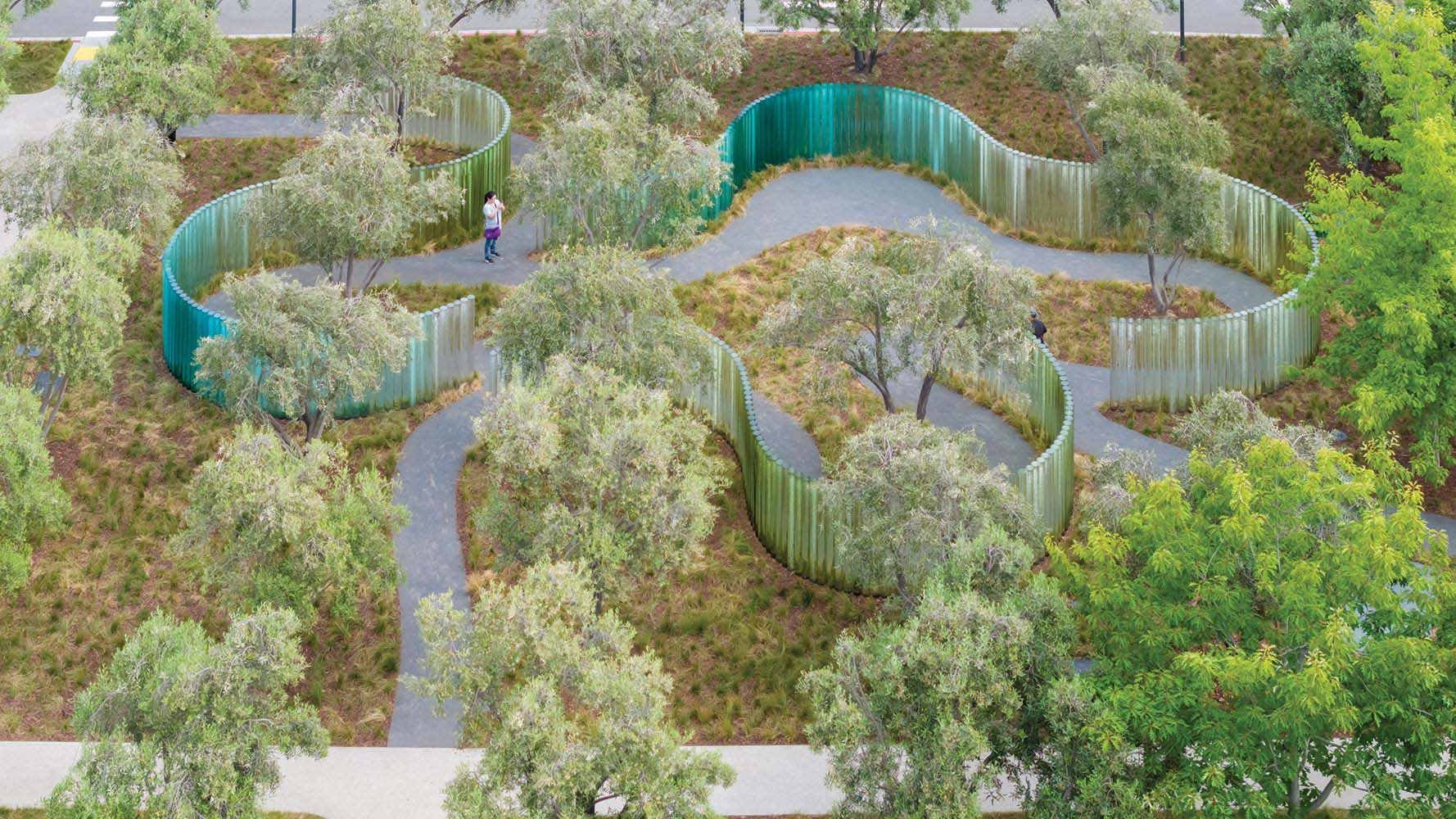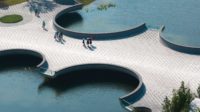Zeller & Moye's Shimmering Glass ‘Mirage’ Snakes Its Way Into Apple Park
Cupertino, California

Architects & Firms
“We see it as an invitation to slow down,” says Zeller & Moye cofounder Ingrid Moye of Mirage, a new public sculpture created by the Berlin- and Mexico City–based architectural studio in collaboration with Scottish artist Katie Paterson. “People will view the artwork, but also focus on nature by looking to the sky, into the trees and landscape, and at other people passing by—and even interact with them.”
These activities—communing with nature and face-to-face human engagement—typically require setting aside one’s handheld device for a screen-free interlude to take it all in. This is a tall order when considering that Mirage is situated on the 175-acre Silicon Valley campus of Apple, a company that found its fortune in screens, mobile or otherwise. Yet the mesmeric work seems up to the task, taking form as a triptych of iridescent glass-columned walls that stand nearly 7 feet tall and weave sinuously through a grove of olive trees to create pockets of open space ideal for both moments of quiet solitude and small group gatherings. From above, the snaking shape of Mirage resembles a glazed garden maze, albeit far less disorienting.

Twisting through an olive grove near the Apple Park visitors center, Mirage is a beguiling backdrop for strolls, picnics, and more. Photo © Iwan Baan, click to enlarge.
“There’s always an interconnection between inside and outside, and you’re never lost” says Christoph Zeller, Moye’s partner in life and in practice at the 2023 Design Vanguard firm. “But there is one point within the artwork where you’re fully surrounded by glass and immersed in a world of color and gradient of light.”
The first permanent public artwork completed at Apple’s corporate compound in Cupertino, California, Mirage’s ribbonlike glass partitions span a 2,250-square-foot site, just across the way from Foster + Partners’ donut-shaped mother ship and adjacent to a visitor center and café where orders are placed via iPad and lattes are presented with Apple-logo foam art. Mirage, however enigmatic, isn’t hidden away on the campus.
“This existing part of the campus was a space of transition,” explains Zeller of the OLIN-designed landscape. “We wanted to frame the section of the park so that people view it not just as a piece of green to walk through but as a destination.”

The undulating form of the sculpture mimics a wind-shaped dune. Photo © Iwan Baan
Mirage is ambitious both conceptually and from sourcing and engineering standpoints. The 400 cast-glass columns comprising the sculpture were fabricated by the Oakland-based studio of glass artist John Lewis, using sand responsibly collected from desert regions across the world with the aid of on-the-ground partners, including UNESCO. No pigments were employed to create the glass; unique formulas for each desert were conceived by the studio’s glassblowers, with assistance from material scientists, to give the pillars innumerable variations in natural color and texture, contrasting with what Zeller calls the sophisticated “invisible” glass at the core of Apple products. (A previous public artwork by Zeller & Moye in collaboration with Paterson, Hollow at Royal Fort Gardens in Bristol, England, incorporates samples from more than 10,000 tree species.)
“The California sun plays a really strong role, charging the glass and bringing the colors to life,” says Zeller. At night, Mirage remains aglow, thanks to integrated lighting concealed by complex architectural detailing.
And although Mirage’s freestanding glass columns emerge from the grass “just standing there like stones” in the words of Zeller, the project was meticulously engineered with underground anchoring preventing the heavy but fragile-looking walls from toppling over, particularly during earthquakes. Says Zeller: “It’s a very pure structure that looks like an artwork, but is also a piece of architecture.”




